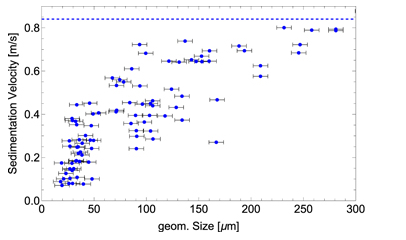Planetary Science Journal (2023); 10.3847/PSJ/acf318
T. Becker, J. Teiser, T. Jardiel, M. Peiteado, O. Munoz, J. Martikainen, J. C. Gomez Martin, J. Merrison, and G. Wurm
Our earlier laboratory measurements showed that low-velocity sand impacts release fine 5 μm dust from a Martian simulant soil. This dust will become airborne in the Martian atmosphere. Here, we extend this study by measuring aerodynamic properties of ejecta and characterizing deviations from the behavior of spherical, monolithic grains. We observe the settling of particles emitted as part of an impact splash. The sizes (20 to 280 μm) and sedimentation velocities (0.1 to 0.8 m s−1) of the particles are deduced from high-speed videos while the particles sediment under low ambient pressure of about 1 mbar. The particles regularly settle slower than expected, down to a factor of about 0.3. Using optical microscopy, the shape of the captured particles is characterized by simple axis ratios (longest/smallest), which show that the vast majority of particles are irregular but typically not too elongated, with axis ratios below 2 on average. Electron microscopy further reveals that the particles are typically porous aggregates, which is the most likely reason for the reduction of the sedimentation velocity. Due to the reduced bulk density, aggregates up to 10 μm in diameter should regularly be a part of the dust in the Martian atmosphere.

Sedimentation velocity over geometrical size (measured particle diameter) of the 92 observed particles. The dashed blue line is the freefall velocity from the dust bed height. For small geometrical sizes, the measured sedimentation velocity varies by up to a factor of 5 between nearly same-sized particles, while it decreases for increasing geometrical sizes.

